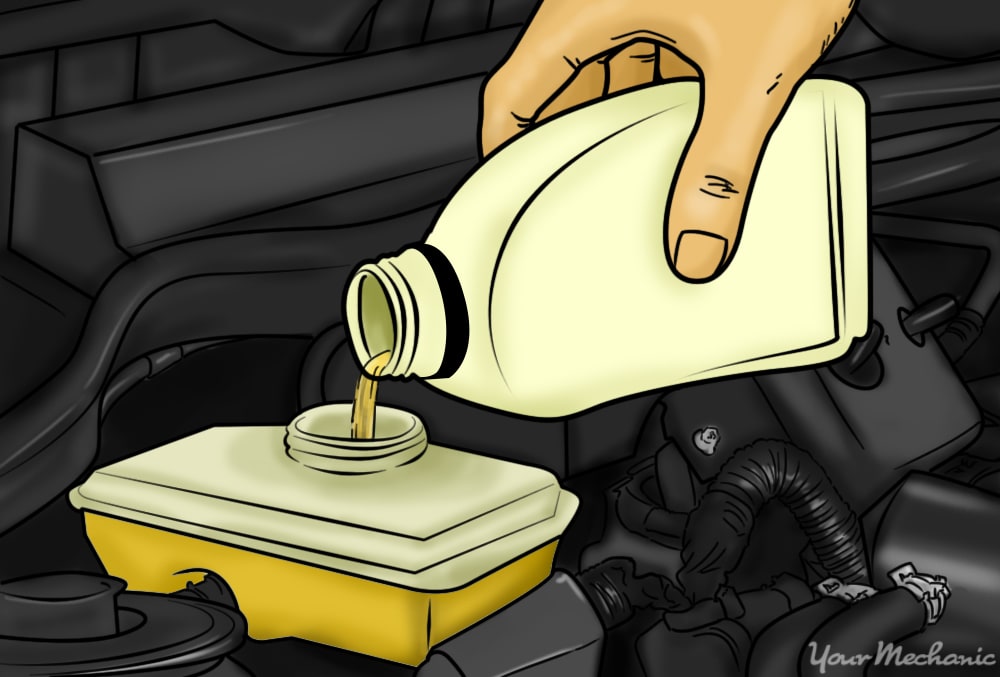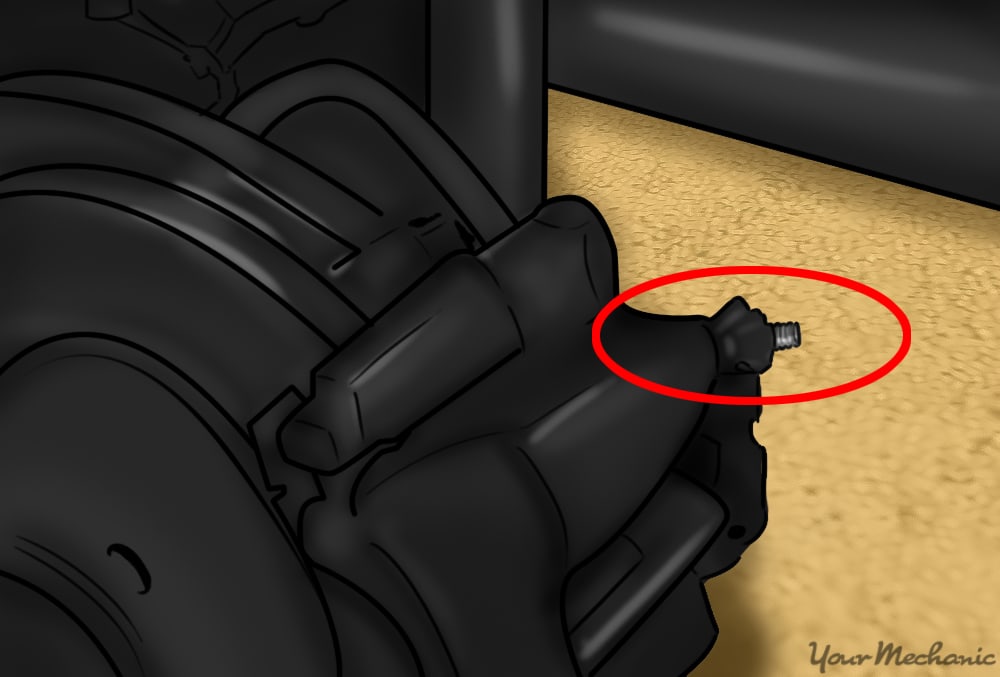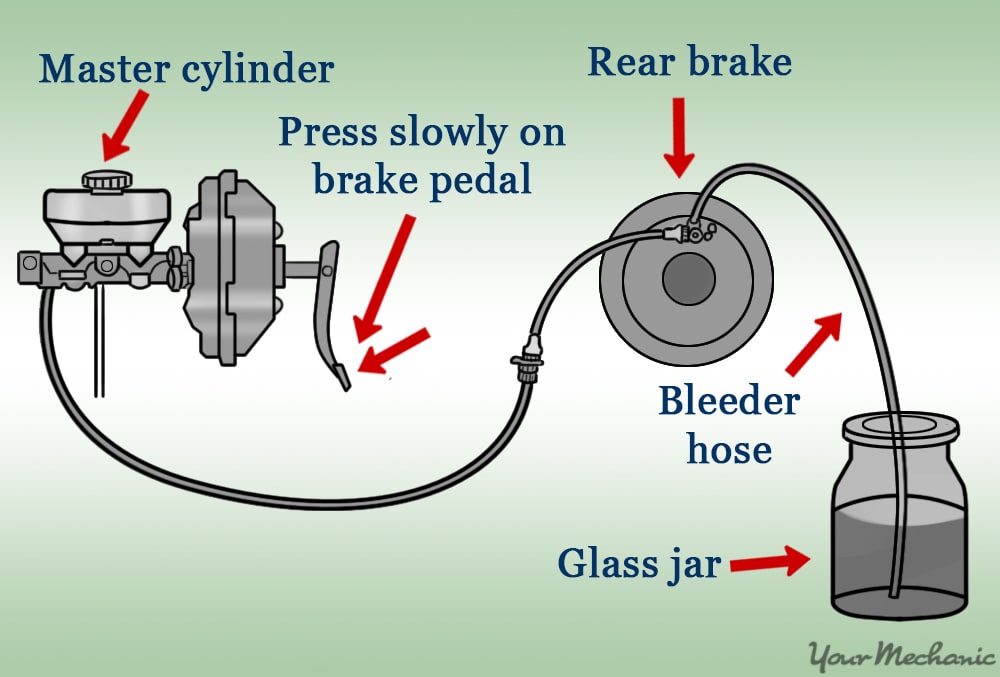

Your car’s brake system is operated by hydraulic pressure — fluid is used in constricted lines to cause movement on the other end.
Hydraulic brake systems have been used for decades. They are reliable, need minimal maintenance, and most problems can be diagnosed and repaired easily.
Brake fluid is hygroscopic, meaning that it absorbs water. This hygroscopic brake fluid prevents interior corrosion of metal lines and seizing of moving parts.
If the brake fluid is contaminated with water, it should be changed with clean fluid from a fresh bottle. If moisture-saturated brake fluid is left in the brake system for too long, damage can occur including:
- Leaking internal brake system seals
- Rusted brake lines
- Seized brake calipers
- Swollen rubber brake hoses
If the brake system requires a part to be replaced such as a brake hose or a caliper, brake fluid may leak out and the reservoir level may become low.
Method 1 of 2: Top up the brake fluid reservoir
If your brake fluid is low or if you’ve performed a brake repair recently, you need to top up the fluid in the reservoir.
Materials Needed
- Clean rag
- Flashlight
- New brake fluid
Step 1: Locate the brake fluid reservoir. The brake fluid reservoir is located in the engine compartment and is mounted on the brake booster against the firewall.
The brake fluid reservoir is opaque or white in color.
Step 2: Check the brake fluid level. The fluid reservoir has markings on the side like “FULL” and “LOW”. Use the markings to identify the fluid level inside the reservoir.
Tip: If you can’t see the fluid, shine a flashlight on the reservoir from the opposite side. You’ll be able to see the top of the fluid.
Note: Don’t open the reservoir to check the level if you can help it. The brake fluid can absorb moisture from the air it is exposed to moisture.
Step 3: Top up the brake fluid. Add the brake fluid to the reservoir so that the level reaches the “FULL” marking. Don’t overfill as it could push out past the cap under pressure.
Match the brake fluid you need with the fluid type mentioned on the brake fluid reservoir cap. Always use a new, unopened container of brake fluid to fill the reservoir.
- Note: Modern cars primarily use either DOT 3 or DOT 4 fluid and the two should never be mixed in applications.
Method 2 of 2: Change your brake fluid
New brake fluid is a honey-brown color. If your brake fluid is dark like the color of used engine oil or a noticeably darker color than new fluid, or if there is a gritty consistency when you rub it between your fingers, you need to change the brake fluid in your car.
Materials Needed
- Axle stand
- Brake bleeder hose
- Brake bleeder wrench
- Car jack
- Empty container
- Lug nut wrench
Step 1: Lift and secure your vehicle. Locate a secure jack point on your car. Consult your owner’s manual to see what types of jacks you can use on your car. Jack up your car until you are able to reach the back of the wheel hub assembly.
Place an axle stand under the frame, wheel hub or axle assembly at the lifted corner for safety. If the jack slips, the axle stand will protect you from injury while you are working underneath your car.
Step 2: Remove the wheel. Use the lug nut wrench to remove the lug nuts of the wheel. It is easier to access the brake bleeder screw with the wheel removed.
Step 3: Open the bleeder screw. The bleeder screw is a hex screw with a hole in the middle. Locate the bleeder screw on the back of the wheel knuckle or on the brake caliper and loosen it.
Turn the bleeder screw counterclockwise a half-turn to loosen it.
Keep backing the bleeder screw off a half-turn at a time until you see drops of brake fluid come from the end.
Step 4: Install the brake bleeder hose. Fit the brake bleeder hose onto the bleeder screw.
- Tip: The brake bleeder hose has a one-way valve inline. Fluid can pass through one way under pressure, but if the pressure is released, fluid cannot be pulled back through it. It makes bleeding the brakes a one-person job.
Step 5: Top up the brake fluid. Use clean brake fluid of the same type as noted on the reservoir lid to top up the brake fluid.
Throughout the process, top up the brake fluid after pressing the brake pedal every 5-7 presses.
- Note: Don’t let the reservoir go empty at any time. Air can enter the brake lines and cause a spongy brake pedal. Air in the lines can be difficult to get out as well.
Step 6: Pump the brakes. Pump the brakes five times, all the way to the floor.
Check the color of the brake fluid in the brake bleeder hose. If the fluid is still dirty, pump the brakes 5 more times. Top up the brake fluid in the reservoir after every interval of pumping the brakes.
The brake fluid change is complete when the fluid looks new in the brake bleeder hose.
Step 7: Reassemble the wheel area. Remove the brake bleeder hose. Tighten the bleeder screw with your wrench.
Put the wheel back on and tighten it with the lug nut wrench.
Remove the axle stand from under your vehicle and lower your car to the ground.
Step 8: Repeat the procedure for all four wheels. After flushing all four lines with clean fluid, the fluid in your whole brake system will be new and the fluid in your reservoir will be clean and new as well.
Step 9: Pump your brake pedal. With everything re-assembled, pump the brake pedal firmly 5 times.
The first time you pump the pedal, it may sink all the way to the floor. It can be surprising, but the pedal will firm up in the next few presses.
- Warning: Do not drive your car before pumping up your brakes. You can be caught in a situation where your brakes don’t function as you expect, leading to accident or injury.
Step 10: Road test your car. Put your car in drive with your foot firmly on the brake pedal.
- Tip: If your car starts to move while your foot is on the brake, put it back in park and pump the brake pedal again. Put your car in drive mode and try your brakes again. Your brakes should hold now.
Drive slowly around the block, testing the brakes regularly to make sure they respond.
- Tip: Always be aware of the location of your emergency brake. In the event your brakes fail, be ready to apply your emergency brake.
Step 11: Check your car for leaks. Pop the hood open and check for brake fluid leaks by the reservoir. Look below the car and check for fluid leaks at each wheel.
- Warning: If fluid leaks are found, do not drive your car until you repair them.
Replace your vehicle’s brake fluid every two to three years in order to maintain the performance of your brakes. Ensure that the brake fluid is at the proper level always. It is relatively simple to replenish the brake fluid on your own. Follow the recommendations in the owner’s manual to determine the correct procedure and brake fluid for your car.
If you find that you still have to pump the brakes for it to work, get a certified mechanic, such as one from YourMechanic, to inspect your brake system. Ask a professional technician to check your brakes if you notice any signs of leaking brake fluid.





